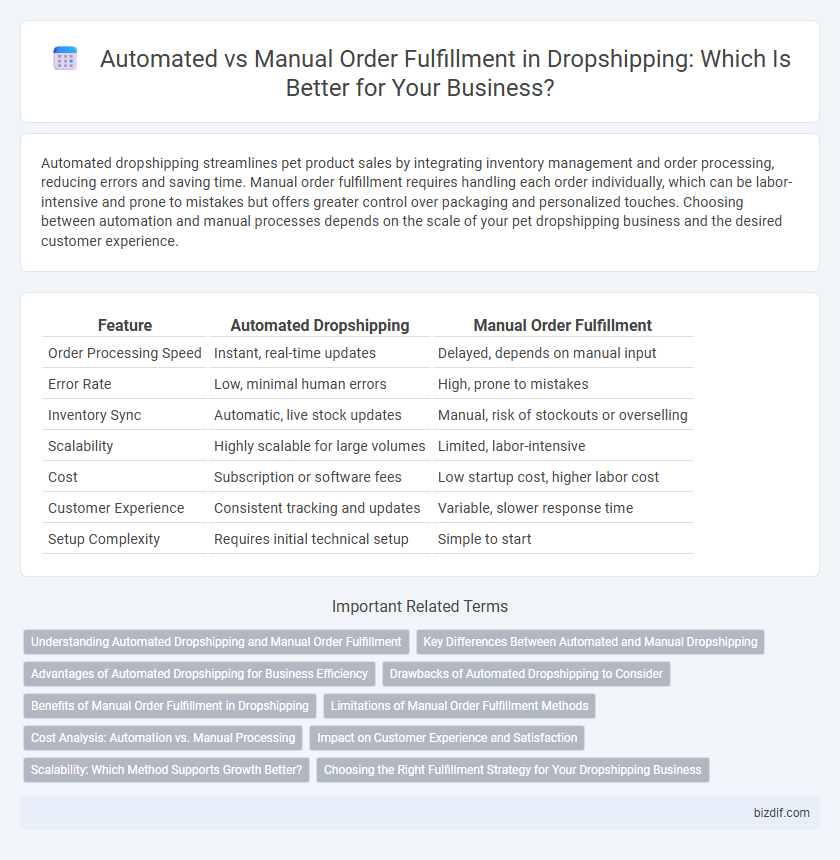Automated dropshipping streamlines pet product sales by integrating inventory management and order processing, reducing errors and saving time. Manual order fulfillment requires handling each order individually, which can be labor-intensive and prone to mistakes but offers greater control over packaging and personalized touches. Choosing between automation and manual processes depends on the scale of your pet dropshipping business and the desired customer experience.
Table of Comparison
| Feature | Automated Dropshipping | Manual Order Fulfillment |
|---|---|---|
| Order Processing Speed | Instant, real-time updates | Delayed, depends on manual input |
| Error Rate | Low, minimal human errors | High, prone to mistakes |
| Inventory Sync | Automatic, live stock updates | Manual, risk of stockouts or overselling |
| Scalability | Highly scalable for large volumes | Limited, labor-intensive |
| Cost | Subscription or software fees | Low startup cost, higher labor cost |
| Customer Experience | Consistent tracking and updates | Variable, slower response time |
| Setup Complexity | Requires initial technical setup | Simple to start |
Understanding Automated Dropshipping and Manual Order Fulfillment
Automated dropshipping streamlines order processing by integrating e-commerce platforms with suppliers' systems, enabling real-time inventory updates and automatic order placement, which reduces errors and saves time. Manual order fulfillment requires sellers to manually verify inventory, process orders, and communicate with suppliers, increasing the risk of delays and human error. Understanding these differences helps businesses optimize efficiency and enhance customer satisfaction in dropshipping operations.
Key Differences Between Automated and Manual Dropshipping
Automated dropshipping leverages software to streamline order processing, inventory management, and tracking, significantly reducing human error and saving time. Manual order fulfillment requires hands-on involvement in managing orders, stock updates, and communication with suppliers, which can increase operational delays and risk of mistakes. Key differences include scalability, efficiency, and accuracy, where automation excels in handling large volumes and maintaining real-time data synchronization across platforms.
Advantages of Automated Dropshipping for Business Efficiency
Automated dropshipping streamlines order processing by integrating inventory management, payment systems, and shipping logistics, reducing human errors and save time. It enables real-time updates on stock levels and order status, ensuring faster delivery and improved customer satisfaction. Businesses benefit from scalability and reduced operational costs, allowing focus on growth and marketing strategies.
Drawbacks of Automated Dropshipping to Consider
Automated dropshipping can lead to inventory synchronization issues, causing stockouts or overselling due to delayed updates from suppliers. Reliance on automation limits customization and control over order fulfillment, often resulting in customer service challenges and delayed issue resolution. Technical glitches or software failures may disrupt order processing, negatively impacting customer satisfaction and business reputation.
Benefits of Manual Order Fulfillment in Dropshipping
Manual order fulfillment in dropshipping offers greater control over order accuracy and product quality, reducing errors and enhancing customer satisfaction. It enables personalized packing and branding, which can strengthen brand identity and foster customer loyalty. This approach also allows for flexible problem-solving and quicker adaptation to unique customer requests or issues that automated systems may overlook.
Limitations of Manual Order Fulfillment Methods
Manual order fulfillment in dropshipping often leads to increased errors and delayed shipping times due to the hands-on processing required for each transaction. This method limits scalability as managing large volumes of orders manually becomes inefficient and prone to oversight. Businesses relying on manual fulfillment face challenges in maintaining accurate inventory levels and providing real-time updates, which can negatively impact customer satisfaction.
Cost Analysis: Automation vs. Manual Processing
Automated dropshipping significantly reduces labor costs by minimizing manual data entry and order handling errors, leading to faster processing times and fewer returns. Manual order fulfillment incurs higher expenses due to increased staffing needs and the risk of human error affecting inventory accuracy and customer satisfaction. Investment in automation software may have an upfront cost but ultimately lowers operational expenses and scales more efficiently compared to the variable costs associated with manual processing.
Impact on Customer Experience and Satisfaction
Automated dropshipping streamlines order processing by reducing errors and speeding up delivery times, significantly enhancing customer experience and satisfaction. Manual order fulfillment, while allowing for personalized oversight, often leads to slower response times and increased risk of mistakes, which can negatively affect customer trust. Prioritizing automation tools in dropshipping operations ensures consistent service quality, fostering higher customer retention and positive reviews.
Scalability: Which Method Supports Growth Better?
Automated dropshipping leverages software integrations to process orders rapidly, supporting scalability through reduced human error and faster fulfillment speeds, enabling businesses to handle increased volume efficiently. Manual order fulfillment becomes increasingly time-consuming and prone to errors as order volume grows, limiting expansion potential due to labor-intensive processes. E-commerce stores aiming for scalable growth benefit from automation tools that streamline order management and inventory synchronization across multiple suppliers.
Choosing the Right Fulfillment Strategy for Your Dropshipping Business
Automated dropshipping streamlines order processing by integrating software that instantly forwards customer orders to suppliers, reducing errors and saving time. Manual order fulfillment provides greater control over inventory and quality but requires more hands-on management and can slow down the shipping process. Selecting the right strategy hinges on balancing efficiency and control based on business size, product complexity, and scalability goals.
Automated Dropshipping vs Manual Order Fulfillment Infographic

 bizdif.com
bizdif.com